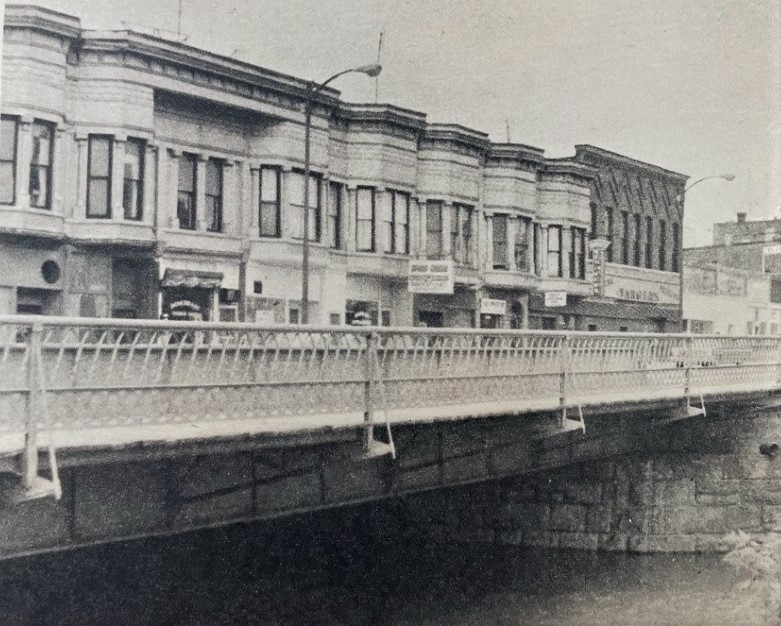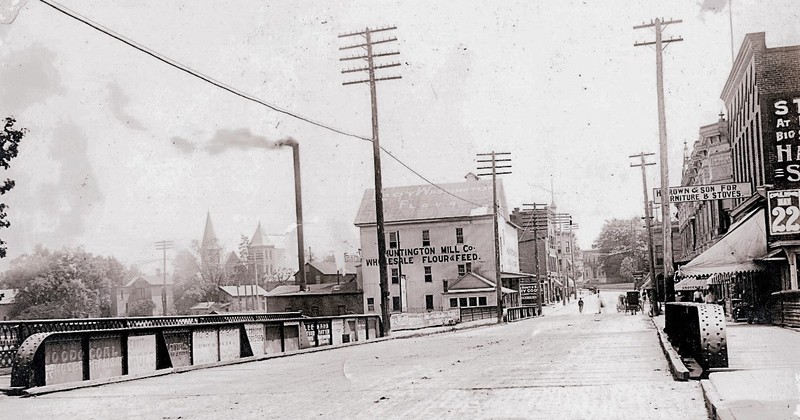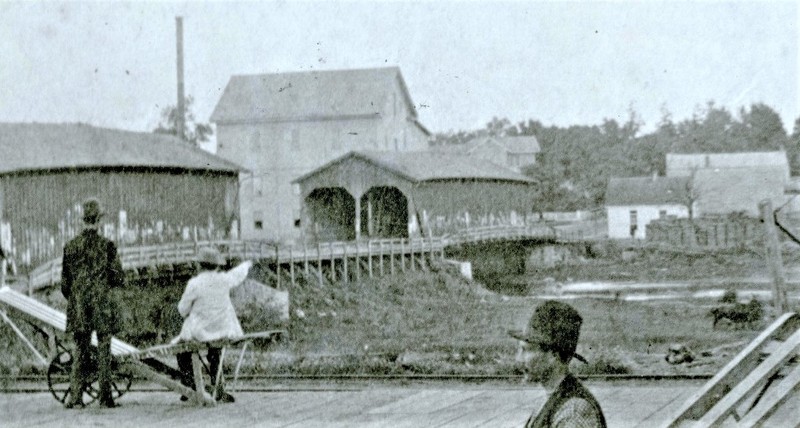Buildings on the Bridge
Introduction
Text-to-speech Audio
Between 1900 and 1977, this bridge was home to several buildings. Prior to the bridge, Native Americans and early settlers forded Little River from Charles Street diagonally across just below the Island to the Court House. A dugout canoe, when hailed, carried pedestrians across for 50 cents. The first truss bridge over the Little River was built here at the ford in 1843. A steel twin bridge was built in 1891 and around 1900, A.J. Johnson erected two-story buildings beside the south span of the bridge. Shops, offices, and dwellings were housed here until the structures were condemned. The Southside Businessmen's Association spruced up the fronts, and the Art Guild donated colorful murals to cover 18 upper windows. Following years of controversy, the buildings were razed in 1977 by order of the state.
Images
Buildings On the Bridge

Early 1900s Jefferson St Bridge

1877 Twin Covered Bridges Over the River

Backstory and Context
Text-to-speech Audio
A pair of covered bridges replaced the ford (a shallow place in the river that allows one to cross on foot or drive across) at Jefferson Street to the Island and then to Drover Town. These bridges appear to have had Multiple Kingpost Trusses and may have been Burr Arches. “In the construction of the bridge originally very little metal was used. The arches and the square timbers were fastened together with wooded pins fashioned by hand as was nearly all parts of the bridges.”
In 1891, the wooden structure was replaced with steel spans connecting Jefferson Street across the Island and from the Island to land on the other shore. The wood from the bridge structure was used in the construction of some of the homes in the area as flooring or studding.
In 1892, only two businesses were located on the Island in the middle of the Little River. After a court decision indicating that Mr. Johnson was not disrupting the flow of the river with his cement abutments even during flood, construction began in earnest. By 1907, seven buildings spanned the south side of the bridge. Rods and truss braces were placed under the buildings due to the settling of the structure. By 1919, both north and south of the island had buildings on the bridge (along with a full set of buildings on the island). While an interesting idea, there was no sewer system and sewage would go right into the river. The buildings fell into disrepair and were condemned in 1966. In September of 1975, the State of Indiana stepped in and ordered the buildings demolished. In July 1977, the buildings were finally torn down. Today there is a large walkway on the bridge to a pavilion.
Sources
- “Building is Settling,” Huntington Herald [Huntington, IN], 9 August 1901
- Sanborn Map Company. Sanborn Fire Insurance Maps: Illinois. Teaneck, NJ: Chadwyck-Healey, 1892, 1904, 1912, 1919.
- “Timbers of Old Bridge,” Morning Times [Huntington, IN], 2 January 1910.
- “Huntington's Buildings over the River / Huntington's Ford and First Bridge,” IN.gov, accessed June 28, 2021, https://www.in.gov/history/state-historical-markers/find-a-marker/drover-town/
- “Will Erect Building Over Channel of River,” The Huntington Press [Huntington, In], 7 July 1914.
- “Huntington’s Ford Covered Bridges,” Bridgehunter.com, accessed June 29, 2021, https://bridgehunter.com/in/huntington/bh89991/
- Huntington City-Township Public Library image collection as posted on Indiana Memory. (https://digital.library.in.gov)
Indianapolis Star Magazine, p208, 19 Jun 1977
Huntington City-Township Public Library image collection
Huntington City-Township Public Library image collection
